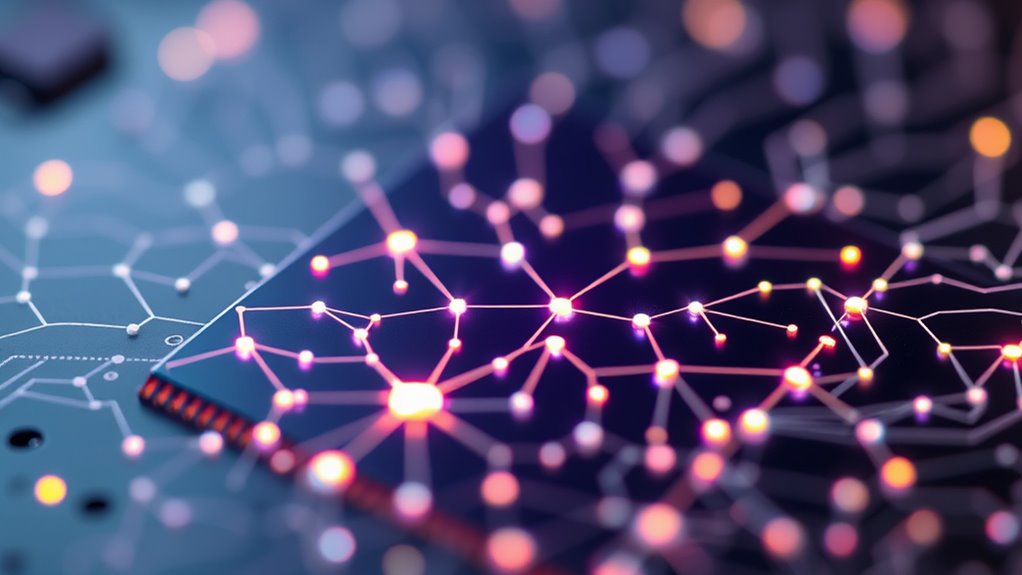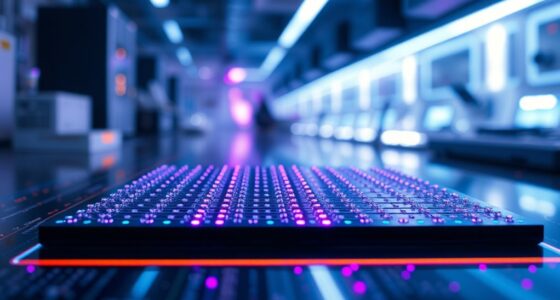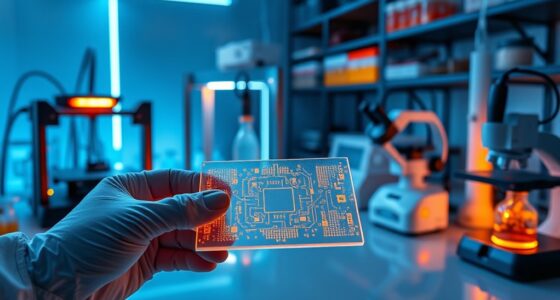Neuromorphic hardware mimics brain synapses by using electronic components like memristors that emulate their adaptive and energy-efficient signaling. These components change their conductance based on activity, allowing the system to learn and store information efficiently without continuous power. By integrating processing and memory, this hardware reduces energy use and supports real-time learning. If you want to discover how these systems replicate biological processes even more closely, keep exploring further.
Key Takeaways
- Neuromorphic hardware uses memristor-based synapse-like components that adjust conductance, mimicking biological synaptic plasticity.
- It integrates processing and memory, reducing data transfer energy and emulating the brain’s efficient information handling.
- These systems enable real-time learning by dynamically tuning connection strengths, similar to synaptic adjustments in neurons.
- High-performance memristors provide accurate, non-volatile state retention, supporting low-power, continuous adaptation.
- Overall, neuromorphic designs replicate synaptic functions to achieve ultra-low power consumption comparable to biological brains.

Advances in neuromorphic hardware are bringing us closer to replicating the brain’s efficiency by mimicking how synapses work. Synapses are the critical junctions where neurons communicate, and their ability to change strength—known as synaptic plasticity—is fundamental to learning and memory. In biological systems, synaptic plasticity allows the brain to adapt and store information efficiently, using minimal energy. Neuromorphic hardware aims to replicate this process by designing electronic components that emulate synapses, enabling neural networks to learn and adapt in a way that closely mirrors biological brains.
Unlike traditional computers that rely on binary logic and separate memory-storage systems, neuromorphic systems integrate processing and memory functions within the same hardware. This integration reduces energy consumption because data doesn’t have to shuttle back and forth between different components. Instead, the hardware’s synapse-like elements dynamically adjust their conductance based on activity, just like real synapses change strength during learning. This capability allows neural networks to perform complex tasks—like pattern recognition or decision-making—more efficiently, with far less power.
Neuromorphic systems combine processing and memory, enabling efficient, real-time learning with lower energy consumption.
The concept of synaptic plasticity is at the heart of this innovation. In the brain, it involves chemical and electrical changes that strengthen or weaken the connection between neurons. Neuromorphic hardware captures this by using memristors or other synapse-mimicking devices that can alter their resistance or conductance in response to stimulation. These devices retain their state even when power is off, enabling a form of non-volatile memory that sustains learned information without continuous energy input. This low-power, adaptable behavior helps create systems that are not only energy-efficient but also capable of lifelong learning.
Furthermore, the development of high-performance memristors has significantly advanced the ability of neuromorphic hardware to mimic biological synapses more accurately. Neural networks implemented on neuromorphic hardware are designed to exploit this dynamic synaptic behavior. They process information in a massively parallel fashion, just like biological networks, which allows for rapid, energy-efficient computation. Because the hardware components can continuously adjust their connection strengths during operation—mimicking synaptic plasticity—they facilitate real-time learning without the need for extensive training phases or high energy costs.
Frequently Asked Questions
How Does Neuromorphic Hardware Adapt to New Learning Tasks?
You leverage plasticity mechanisms in neuromorphic hardware to adapt to new learning tasks. These mechanisms enable the system to modify synaptic weights dynamically, similar to biological brains. Learning algorithms guide this process, allowing the hardware to refine its responses based on new data. As a result, your neuromorphic device becomes more flexible, efficiently learning and adjusting without needing extensive reprogramming, making it ideal for diverse, real-world applications.
What Materials Are Used to Emulate Synaptic Behavior in Hardware?
You’ll find that memristor materials and phase change compounds are key in emulating synaptic behavior. Memristors, made from materials like metal oxides, can change resistance to mimic learning processes. Phase change compounds, such as chalcogenides, switch between states to replicate synaptic weights. These materials enable hardware to adapt and learn efficiently, closely mimicking brain synapses while consuming ultra-low power, making them essential for neuromorphic computing advancements.
Can Neuromorphic Systems Operate in Real-Time Environments?
You can see that neuromorphic systems operate effectively in real-time environments, thanks to their energy efficiency and sensory integration capabilities. They process information quickly and adaptively, mimicking brain functions to handle dynamic data streams. This allows them to respond instantly to stimuli, making them ideal for applications like robotics and autonomous systems where real-time performance is vital. Their low power consumption ensures sustained operation without overheating or excessive energy use.
How Scalable Are Current Neuromorphic Architectures?
You might wonder about the scalability of current neuromorphic architectures. While they show promise, scalability challenges remain due to architecture limitations like limited neuron and synapse integration. As you expand these systems, you face issues balancing power efficiency and hardware complexity. Overcoming these hurdles will require innovative designs, but progress continues. Ultimately, addressing architecture limitations is key to making neuromorphic systems more scalable for broader applications.
What Are the Main Challenges in Commercializing Neuromorphic Chips?
You’ll find that commercializing neuromorphic chips faces major hurdles like market adoption and manufacturing challenges. Visualize a delicate balance; just as a brain seamlessly adapts, these chips need reliable, scalable production methods. Overcoming these issues requires innovative manufacturing techniques and convincing industries of their benefits. Without addressing these challenges, neuromorphic technology may struggle to gain widespread use, despite its promising low power and high efficiency.
Conclusion
By mimicking brain synapses, neuromorphic hardware paves the way for powerful, passive, and pocket-sized processing. You can see how striking simplicity supports sophisticated solutions, sparking a smarter, smaller future. Embrace this breakthrough, where brain-inspired brilliance brings boundless benefits with barely a blink of power. As technology takes a transformative turn, neuromorphic networks nurture new notions of natural, nuanced, and near-instant computing—making modern miracles possible with minimal means.









